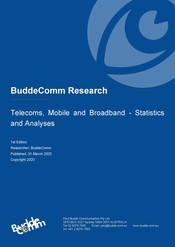2016 Latin America - Fixed Broadband Market - Statistics and Analyses

Last updated: 17 May 2016 Update History
Report Status: Archived
Report Pages: 187
Analyst: Henry Lancaster
Publication Overview
This report covers developments in the Broadband markets of Latin America. The countries covered in this report include:
Argentina, Belize, Bolivia, Brazil, Chile, Columbia, Costa Rica, Dominican Republic, Ecuador, El Salvador, Guatemala, Guyana, Haiti, Honduras, Jamaica, Mexico, Nicaragua, Panama, Paraguay, Peru, Puerto Rico, Suriname, Uruguay and Venezuela.
Researchers:- Henry Lancaster
Current publication date: May 2016 (12th Edition)
Executive Summary
Government initiatives supporting broadband connectivity across the region
Although fixed broadband penetration in the LAC region remains below the global average, and significantly so in a number of Central American countries, in recent years there has been a greater appreciation among policy makers that higher broadband penetration translates to economic productivity and growth in GPD. The varied social benefits of broadband adoption are well known, and thus social inclusion, as well as reducing the digital divide between urban and rural communities, forms the cornerstone of government-sponsored national broadband strategies. Poor fixed-line infrastructure in many areas of the region remains a legacy of under-investment, which is being tackled through a number of projects having national scale. Governments have also promoted projects which provide subsidised computers and free Wi-Fi connectivity in a bid to address relatively low computer penetration and low use of broadband services.
Providers have been required to contend with limited revenue growth, exacerbated by relatively low ARPU and low purchasing power among many subscribers, and with high capital cost required for new infrastructure builds and upgrades. In consequence, most fibre deployment thus far has been limited to affluent suburbs within certain cities, where operators can expect a higher take-up of services.
However, the convergence of mobile and fixed-line services, and the growing popularity of OTT delivered content, has encouraged operators to invest in infrastructure in a bid to develop their bundled service offerings, and so attract new customers and reduce churn. The creation of integrated mobile and fixed networks enables providers to offer a full portfolio of services to customers while reducing operating costs.
While investment in fixed-line infrastructure continues, the market in coming years will benefit from the mobile sector where the principal regional operators are scaling up their network upgrades to provide wide-spread and increasingly affordable mobile broadband and data offers. Growth in mobile data requires additional investment in backhaul infrastructure.
There remain wide differences in broadband penetration among the countries of the region. Some countries within the Caribbean, as well as Uruguay, Chile, Argentina, and Mexico have the highest fixed-line broadband penetration rates in the region. By contrast, countries including Haiti, Paraguay, Cuba and most Central American countries have particularly low penetration. Generally, higher broadband penetration can be found in the southern countries and some of the wealthier Caribbean islands (particularly those with economies strongly dependent on tourism), while the lower rates are prevalent in Central America and in the poorer countries on the northwest coast and interior of South America.
Governments have taken an increasingly active part in promoting broadband adoption and facilitating the deployment of infrastructure. This is partly due to concerns related to social inclusion, but is mostly related to efforts to improve faltering economies and encourage growth in GDP. Improved international connectivity has also played an important part in the overall picture, with higher bandwidth leading to dramatically lower access costs for consumers, which in turn has encouraged broadband adoption among the lower socio-economic demographic.
Henry Lancaster
Data in this report is the latest available at the time of preparation and may not be for the current year.
Related Reports
- Caribbean - Telecoms, Mobile and Broadband - Statistics and Analyses
- 2019 Latin America - Mobile Network Operators and MVNOs
- Panama - Telecoms, Mobile and Broadband - Statistics and Analyses
- Brazil - Telecoms, Mobile and Broadband - Statistics and Analyses
- Chile - Telecoms, Mobile and Broadband - Statistics and Analyses
- Jamaica - Telecoms, Mobile and Broadband - Statistics and Analyses
- Puerto Rico - Telecoms, Mobile and Broadband - Statistics and Analyses
- Uruguay - Telecoms, Mobile and Broadband - Statistics and Analyses
- Paraguay - Telecoms, Mobile and Broadband - Statistics and Analyses
- Suriname - Telecoms, Mobile and Broadband - Statistics and Analyses
Share this Report
TMT Intelligence
A platform to scale your intelligence tasks
Monitor critical insights with our AI-powered Market Intelligence Platform gathering and analyzing intelligence in real time. With AI trained to spot emerging trends and detect new strategic opportunities, our clients use TMT Intelligence to accelerate their growth.
If you want to know more about it, please see:
Research Methodology
BuddeComm's strategic business reports contain a combination of both primary and secondary research statistics, analyses written by our senior analysts supported by a network of experts, industry contacts and researchers from around the world as well as our own scenario forecasts.
For more details, please see:
More than 4,000 customers from 140 countries utilise BuddeComm Research
Are you interested in BuddeComm's Custom Research Service?
Hot Topics
News & Views
Have the latest telecommunications industry news delivered to your inbox by subscribing to BuddeComm's weekly newsletter.